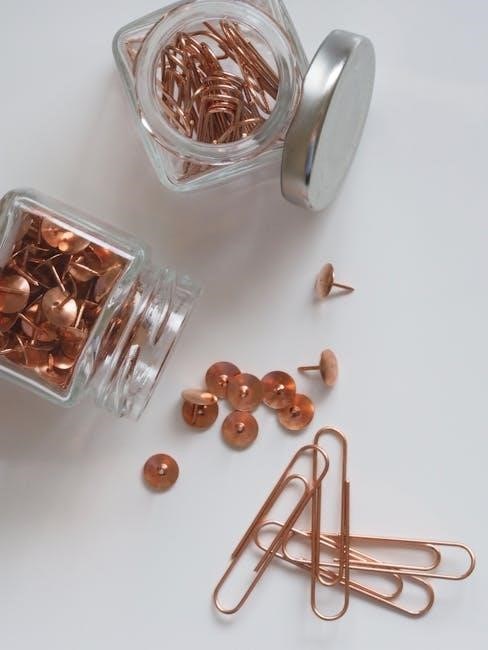Guide Pins: A Comprehensive Overview
Guide pins, essential components in various industries, ensure precision alignment and structural support․ These cylindrical rods, often made of hardened steel, play a crucial role in applications ranging from die sets to robotics, enhancing assembly accuracy and reducing errors․
Guide pins, also known as guide posts or pillars, are fundamental components used in conjunction with guide bushings to achieve precise alignment between upper and lower die shoes․ These cylindrical pins, typically manufactured from hardened tool steel and precision-ground, ensure accurate positioning within tolerances as tight as 0․0001 inches․ Their primary function is to maintain stability, limit contact damage, and facilitate accurate component assembly in various applications․ Guide pins are vital in industries such as die sets, molds, and industrial machinery, where precise alignment is critical for operational efficiency and product quality․ They contribute to structural support, minimize assembly errors, and enhance the overall performance of mechanical systems․
Types of Guide Pins
Guide pins come in various types, each designed to suit specific applications and requirements․ The two basic types are friction (plain bearing) guide pins and ejector guide pins․ Friction guide pins are commonly used for general alignment purposes, providing a reliable and straightforward solution for die sets and molds․ Ejector guide pins, on the other hand, are specifically designed for use with ejector plates in molding and casting processes․ These pins ensure smooth movement and correct alignment of the ejector plates, facilitating the efficient removal of molded parts․ Other variations may include different head styles, materials, and coatings to enhance performance and durability in diverse industrial environments․
Friction (Plain Bearing) Guide Pins
Friction guide pins, also known as plain bearing guide pins, are fundamental components used to align die shoes with precision․ These pins are typically cylindrical and crafted from hardened tool steel, precision-ground to exacting tolerances․ Their primary function is to ensure accurate alignment between the upper and lower parts of a die set, minimizing misalignment and preventing damage during operation․ Friction guide pins rely on a close fit with guide bushings to maintain alignment, with the friction between the pin and bushing providing stability․ Regular lubrication is essential to reduce wear and ensure smooth operation, making them suitable for a wide range of applications․
Ejector Guide Pins
Ejector guide pins are vital components in the molding and casting industries, primarily used to ensure the smooth and accurate movement of ejector plates within molds․ These pins facilitate the proper alignment of the ejector system, ensuring that parts are ejected cleanly and efficiently from the mold cavity․ Ejector guide pins are designed to withstand the forces exerted during the ejection process, maintaining alignment and preventing damage to the mold or the ejected parts․ Their robust construction and precise dimensions contribute to the overall reliability and performance of the molding process, reducing downtime and improving production quality․ Proper maintenance and lubrication are essential for their longevity․
Materials Used in Guide Pins
Guide pins are manufactured using a variety of materials, each selected for its specific properties and suitability for different applications․ The choice of material depends on factors such as the required strength, wear resistance, and operating environment․ Steel alloys, particularly hardened tool steel, are commonly used due to their high strength and durability․ Stainless steel is preferred for applications requiring corrosion resistance, such as in medical or marine environments․ Other materials, such as brass and titanium, may be used in specialized applications where specific properties like electrical conductivity or lightweight are needed․ The selection of the appropriate material is critical for ensuring the performance and longevity of guide pins․
Steel Guide Pins
Steel guide pins are widely utilized due to their robust strength and cost-effectiveness․ Typically crafted from hardened tool steel, these pins offer exceptional durability and resistance to wear, making them suitable for demanding industrial applications․ They are precision-ground to ensure tight tolerances and accurate alignment․ Case hardening is a common treatment to enhance surface hardness while maintaining core toughness․ Steel guide pins are available in various grades, each offering different levels of hardness and wear resistance․ They are ideal for use in die sets, molds, and machinery where high precision and structural integrity are paramount․ Proper lubrication is essential to minimize friction and extend their lifespan․
Stainless Steel Guide Pins
Stainless steel guide pins are chosen for applications requiring corrosion resistance and durability in harsh environments․ These pins offer excellent protection against rust and chemical degradation, making them ideal for use in medical, marine, and food processing industries․ The chromium content in stainless steel forms a passive layer, preventing corrosion․ While not as hard as tool steel, stainless steel guide pins still provide adequate strength and precision for many alignment tasks․ They are often used in conjunction with stainless steel bushings to maintain consistent performance․ Stainless steel guide pins are easy to clean and maintain, ensuring long-term reliability in demanding conditions․
Applications of Guide Pins
Guide pins find extensive use across various industries due to their ability to ensure precise alignment and structural support․ In die sets and molds, they guarantee accurate mating of components, preventing misalignments that could damage tooling․ Industrial machines rely on guide pins for stable and repeatable positioning of parts, contributing to operational efficiency․ In robotics, these pins enable precise movements and secure connections in robotic arms and assembly systems․ Guide pins are also found in automotive assembly, electronics manufacturing, and aerospace applications, where accuracy and reliability are paramount․ Their widespread adoption underscores their importance in achieving consistent and high-quality results in diverse manufacturing processes․
Die Sets and Molds

In die sets and molds, guide pins are crucial for ensuring precise alignment between the upper and lower die shoes․ These pins, often working in conjunction with guide bushings, guarantee that the two halves of the die or mold come together accurately, preventing misalignment and potential damage․ This precise alignment is essential for producing parts with consistent dimensions and tight tolerances․ Guide pins also help to distribute clamping forces evenly, which minimizes mold distortion and enhances the lifespan of the tooling․ Moreover, they facilitate smoother and more efficient operation, reducing downtime and improving overall productivity in manufacturing processes involving dies and molds․

Industrial Machines
In the realm of industrial machines, guide pins play a vital role in ensuring the accurate alignment and smooth operation of various components․ These pins are frequently used in machinery where precise and repeatable movements are necessary, such as in assembly lines, electronic equipment, and quick-change tooling systems․ By providing structural support and maintaining alignment, guide pins help to minimize vibrations, reduce wear and tear, and prevent potential damage to sensitive parts․ Their presence contributes significantly to the overall stability and reliability of industrial machines, ensuring consistent performance and extending the lifespan of the equipment․ They also simplify assembly and maintenance procedures, reducing errors and downtime․
Robotics
Within the field of robotics, guide pins are indispensable for achieving the precise and repeatable movements required for various tasks․ These pins are used in robotic arms, automated assembly systems, and other robotic devices to ensure that components are aligned correctly and move smoothly․ The use of guide pins in robotics contributes to increased accuracy, reduced error rates, and improved overall performance․ They also help to protect delicate robotic components from damage by preventing misalignment and excessive force․ Furthermore, guide pins facilitate the quick and easy assembly and disassembly of robotic systems, making maintenance and repairs more efficient․ Their role is crucial in maintaining the reliability and precision of robotic applications․
Factors to Consider When Selecting Guide Pins
Choosing the right guide pins involves several critical considerations․ First, assess the size and dimensions needed for your specific application, ensuring they fit properly and provide adequate support․ Material compatibility is also vital; select materials that withstand the operating environment and won’t corrode or degrade․ Consider the environmental conditions, such as temperature, humidity, and exposure to chemicals, to ensure the guide pins maintain their integrity․ The required level of precision and the frequency of assembly and disassembly are further important factors․ Finally, account for any potential loads and stresses the guide pins will endure, selecting those with sufficient strength and durability․ These considerations guarantee optimal performance and longevity․
Size and Dimensions
When selecting guide pins, size and dimensions are paramount․ The pin’s diameter must precisely match the corresponding bushing to ensure smooth, accurate alignment․ Length is equally crucial; too short, and the pin won’t provide adequate guidance; too long, and it may interfere with other components․ Consider the overall assembly’s size and weight to determine the appropriate pin dimensions․ For precision applications, tighter tolerances are essential․ Larger pins are typically needed for heavier loads and increased stability․ Always consult manufacturer specifications and consider the specific requirements of your application to choose the optimal size and dimensions for your guide pins․ Proper sizing prevents misalignment and ensures efficient operation․
Material Compatibility
Material compatibility is a critical factor when selecting guide pins․ Ensure the pin material is compatible with the materials of the components it guides, preventing corrosion or galling․ Dissimilar metals can lead to galvanic corrosion, compromising the pin’s integrity and the assembly’s performance․ Consider the operating environment; for high-temperature applications, choose heat-resistant materials․ In corrosive environments, stainless steel or coated pins are preferable․ The hardness of the guide pin should also be compatible with the bushing material to minimize wear․ Proper lubrication can mitigate friction and extend the life of both the pin and bushing․ Careful consideration of material compatibility ensures long-term reliability and prevents premature failure of the guide pin․

Environmental Conditions
Environmental conditions significantly influence the selection of guide pins; Factors like temperature, humidity, and exposure to chemicals or radiation must be considered․ High temperatures can affect the pin’s material properties, leading to expansion or softening․ Humid environments may cause corrosion, especially in carbon steel pins․ Chemical exposure can degrade certain materials, necessitating the use of corrosion-resistant alloys․ Radiation can also alter the material structure over time․ Choose guide pins made from materials that can withstand the specific environmental conditions of the application․ Consider coatings or surface treatments to enhance resistance to corrosion or wear․ Regular inspection and maintenance are essential to ensure continued performance in harsh environmental conditions․ Selecting the right guide pin material based on the environment ensures longevity and reliability․
Benefits of Using Guide Pins

Guide pins offer numerous benefits across various applications, primarily ensuring precision alignment during assembly․ Their use minimizes the risk of misalignment, leading to improved product quality and reduced rework․ Guide pins also provide structural support, distributing clamping forces evenly to prevent distortion in molds and die sets․ This support enhances the stability and longevity of the equipment․ Furthermore, guide pins simplify the assembly process, reducing the potential for human error․ They facilitate quick and accurate positioning of components, saving time and labor․ By maintaining precise alignment, guide pins contribute to smoother operation and reduced wear on machinery․ The benefits of using guide pins extend to increased efficiency, improved product quality, and cost savings in the long run․
Precision Alignment
Precision alignment is a primary benefit of utilizing guide pins in various industrial applications․ These pins ensure that components are perfectly aligned during assembly, minimizing errors and improving overall product quality․ The accurate positioning facilitated by guide pins is crucial in processes where even slight misalignments can lead to significant problems․ In die casting and molding, precision alignment ensures consistent part production and reduces the need for rework․ Furthermore, guide pins contribute to the stability and longevity of machinery by preventing undue stress and wear caused by misaligned parts․ The use of guide pins for precision alignment ultimately enhances efficiency, reduces costs, and improves the reliability of assembled products․ This precise positioning is vital for achieving optimal performance in various mechanical systems․
Structural Support
Beyond precision alignment, guide pins offer significant structural support in various assemblies․ These pins help distribute clamping forces evenly, preventing distortion and ensuring the stability of the entire structure․ By providing additional support, guide pins reduce stress on other components, extending their lifespan and maintaining the integrity of the assembly․ This is particularly important in applications involving heavy loads or repetitive motion, where structural integrity is critical for safe and efficient operation․ In die sets and molds, guide pins withstand the immense pressures involved in the molding process, preventing misalignment and ensuring consistent part quality․ The enhanced structural support provided by guide pins contributes to the overall reliability and durability of the assembled system, making them indispensable in demanding industrial environments․
Reduced Assembly Errors
Guide pins significantly contribute to reduced assembly errors by ensuring accurate alignment of components during the assembly process․ Their presence minimizes the chances of misalignment, which can lead to defects, rework, or even complete failure of the assembly․ By providing a precise reference point, guide pins simplify the assembly process and make it easier for workers to assemble components correctly․ This is particularly important in complex assemblies with multiple parts, where even small misalignments can have significant consequences․ Guide pins also enable faster assembly times, as workers spend less time adjusting and aligning components․ The resulting decrease in errors leads to improved product quality, reduced production costs, and increased overall efficiency․ Furthermore, guide pins can prevent damage to components during assembly by guiding them into place, minimizing the risk of collisions or other forms of damage․
Alternatives to Guide Pins
While guide pins offer numerous benefits, alternative methods exist for achieving alignment and support in various applications․ Vision systems can be employed to guide robotic assembly processes, using cameras and image processing to ensure accurate component placement․ Alignment jigs and fixtures provide a physical means of aligning parts, often used in welding and other manufacturing processes․ In certain applications, self-aligning fasteners can compensate for slight misalignments between components․ Adhesive bonding may also be used as an alternative to mechanical alignment methods, particularly in lightweight assemblies․ For less demanding applications, careful manual alignment may suffice, though this is more prone to error․ The choice of alternative depends on factors such as precision requirements, assembly volume, cost considerations, and the specific characteristics of the components being assembled․ Each alternative presents unique advantages and disadvantages compared to using guide pins, requiring careful evaluation for optimal application․




Leave a Reply
You must be logged in to post a comment.